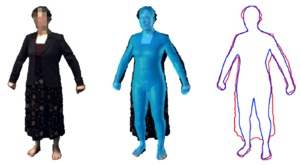A 2D human body model dressed in eigen clothing
2010
Conference Paper
ps
Detection, tracking, segmentation and pose estimation of people in monocular images are widely studied. Two-dimensional models of the human body are extensively used, however, they are typically fairly crude, representing the body either as a rough outline or in terms of articulated geometric primitives. We describe a new 2D model of the human body contour that combines an underlying naked body with a low-dimensional clothing model. The naked body is represented as a Contour Person that can take on a wide variety of poses and body shapes. Clothing is represented as a deformation from the underlying body contour. This deformation is learned from training examples using principal component analysis to produce eigen clothing. We find that the statistics of clothing deformations are skewed and we model the a priori probability of these deformations using a Beta distribution. The resulting generative model captures realistic human forms in monocular images and is used to infer 2D body shape and pose under clothing. We also use the coefficients of the eigen clothing to recognize different categories of clothing on dressed people. The method is evaluated quantitatively on synthetic and real images and achieves better accuracy than previous methods for estimating body shape under clothing.
| Author(s): | Guan, P. and Freifeld, O. and Black, M. J. |
| Book Title: | European Conf. on Computer Vision, (ECCV) |
| Pages: | 285--298 |
| Year: | 2010 |
| Month: | September |
| Publisher: | Springer-Verlag |
| Department(s): | Perceiving Systems |
| Research Project(s): |
Deformable Structures
|
| Bibtex Type: | Conference Paper (inproceedings) |
| Paper Type: | Conference |
| Links: |
pdf
data |
| Attachments: |
poster
|
|
BibTex @inproceedings{Guan:ECCV:10,
title = {A {2D} human body model dressed in eigen clothing},
author = {Guan, P. and Freifeld, O. and Black, M. J.},
booktitle = {European Conf. on Computer Vision, (ECCV)},
pages = {285--298},
publisher = {Springer-Verlag},
month = sep,
year = {2010},
doi = {},
month_numeric = {9}
}
|
|




